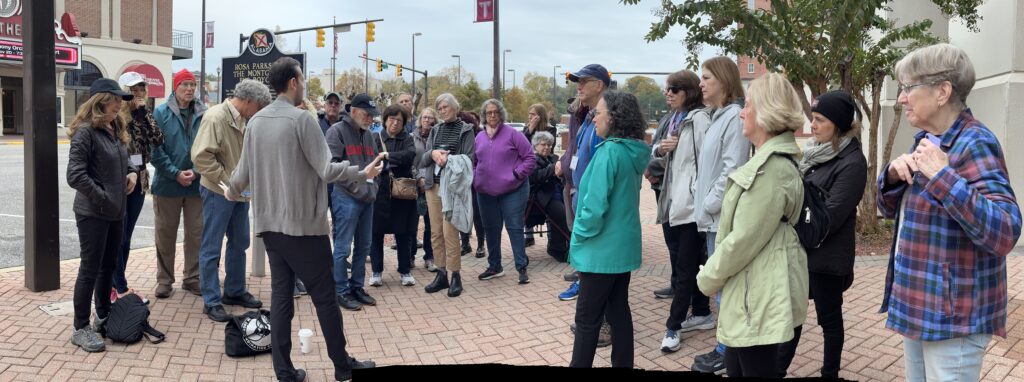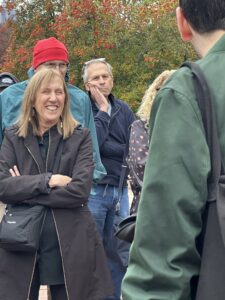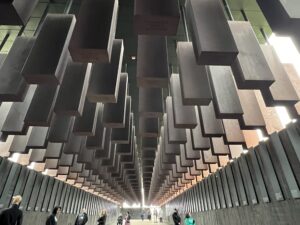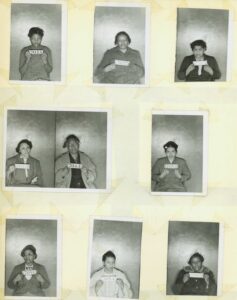Risa’s opening remarks and the reflections were shared at MLK Shabbat (1/13/24). Participants in the November 2023 Civil Rights trip were asked to share one powerful and specific impression from their experience.
As most of you know, a group of 33 Shomrei members traveled together to the deep South this past November for a Civil Rights Educational trip. How fitting that we, as we gather again on this special MLK Shabbat, we remember that it was LAST year’s MLK Shabbat, and the moving sermon from Rabbi Justus around issues in Black and Jewish relations, that inspired us to travel.
In listening to some of Rabbi Justus’ insights from trips with similar itineraries, many of us were moved … and thinking how impactful it would be for us to take part in a like-minded learning journey.
So here we are, 2 months post-travel, and for many of us, the entire experience was life-changing. We all went thinking we knew something about the civil rights movement and its history. Some of us were more directly involved than others at the time. But to a person, no one was prepared for the power and enormity of what we saw, what we learned, and how all that we bore witness to has changed us.
One can read about the horrors of random and mass lynchings, and not begin to experience the atrocity as you do when you enter the Lynching Memorial in Montgomery, Alabama. You cannot even see past all the columns literally hanging from above. A column from every state. So many counties. So many names. So much complicity.
The question of complicity is haunting. How could this have happened in our country? On our watch? In our silence? How can it still be?
In the museums we visited, we learned the linear African American story that began with the horrors of slavery, finally gave way to short-lived emancipation and reconstruction, and then quickly incited Jim Crow laws and mass lynching, and ultimately morphed into today’s approach to mass incarceration as a new embodiment of bias and injustice.
So much work still undone. So much progress still to be made. As we returned home to our daily lives, we felt a new responsibility to continue the work that needs doing. No one told us that in our travels. Rather, the power of the experience led all of us to that inexorable conclusion … and commitment.
And so we will continue to commit as a community.
Because we stand at the brink of hatred and bias still, AND again.
And it is such a powerful reminder that in silence IS complicity, and in humanity, there is no room to curse the darkness but only to be the light.
Let’s hear some of the moving reflections of several of our fellow Civil Rights travellers:
We thought we knew the history of the Civil Rights movement. We were teenagers in the 1960”s and involved in several social action efforts. However, this trip proved that there is so much more history that we were not really aware of and the emotions that we felt as we learned from people directly involved are not easily described. It was so meaningful to experience this learning with our own community and to understand that the community is often what helps us deal with adversity.
It is difficult to pick only one or two experiences that impacted us personally as every interaction was enlightening and educational. Seeing the Equal Justice Initiative’s National Memorial for Peace & Justice with the names of several people who had been lynched really affected us. The hanging pillars row after row were overwhelming. It was so unnerving, and the names just seemed to go on and on. We just kept wandering around as if we were lost but actually, we were just trying to absorb the enormity of the injustice that occurred.
We have read about the courage and bravery of so many in the movement but meeting with people who were involved enhanced our understanding and we still talk about how Linda Lowery and the Rev Calvin Woods are proud of what they accomplished and do not hold hate in their hearts. Their positive attitudes after their experiences continue to amaze us.
We will be thinking about what we saw, learned, and experienced for a long time and we hope that we can use what we have learned to further understanding and tolerance in our own community.
I was deep in the slavery section, only one-fourth of the way through the Equal Justice Initiative’s amazing Legacy Museum, when I heard an announcement that our bus was leaving in 30 minutes. Flustered, I began rushing through one room after the next, depictions of racial terrors blurring into signs for “colored” and white water fountains. Speeding through the segregation section, hoping to focus my remaining time on mass incarceration, I suddenly had to stop. There in front of me was an entire wall displaying 69 black and white photographs – mug shots — of Black men and women arrested on the first day of the Montgomery Bus Boycott in 1955. They were people I’d never heard of, except for Martin Luther King and Rosa Parks. Everyone appeared to have dressed up that day. No one wore the garb of maids or janitors. No one looked frightened. Rather, they exuded a quiet dignity and unbreakable resolve. Each was charged with violating an Alabama state law that forbade boycotts without “a just cause.” Looking at each person’s face, I tried to imagine the courage it took for a Black person to break the law–the racial code–in 1955, when there was not yet a civil rights movement in this country. Martin Luther King was a 25-year-old, newly minted pastor of Dexter Avenue Baptist Church, virtually unknown outside Montgomery. Those who participated in the boycott could have been beaten to a pulp by racist police officers or Klansmen. Or fired from their jobs. Their homes could have been bombed. Yet 40,000 Black riders boycotted the buses that day and for the next 380 days — ordinary people banding together to right a wrong. In doing so, they gave birth to the Civil Rights Movement, which changed the world.
Aileen Grossberg
There were so many lasting images from the Civil Rights trip in November as I wrote in Shomrei Week, summing up the experience. However, the one that keeps floating in front of my eyes is the sea of heads and busts which appear to drown as the ocean’s waves rush over them and almost to the viewer. The movement of the waves is mesmerizing. Each time the waves recede, uncovering the heads, the viewer sees more of the individuals- the men, women and children- who died on their way across the Atlantic Ocean. They stare out with dignity, agony and resignation on their faces. I saw this as a tribute to lives lost, to futures never realized, to talents undiscovered. The installation also brought to mind our Jewish liturgy which contemplates who will die by water and who by fire and the Holocaust with its loss of millions of lives and potential. The power of hate and dehumanization to destroy is incalculable, insidious, and knows no limits.
Rabbi Julie
Standing in front of the ocean, in the entry to the Equal Justice Initiative museum, surrounded by the sounds of waves crashing and the image of the turbulent waters projected onto a screen as big as the wall, I felt viscerally for the first time in my life the immense cruelty of slavery. Standing in the midst of the waters, where more than 12 million Africans were ripped from their homes and forcibly brought to American shores, I remember thinking that 12 million was twice the number of Jews killed in the Holocaust. There I faced the vast ocean as a starting point of an ever-evolving dehumanization, hatred, and violence against Black people that began with slavery and morphed into lynching, segregation, and mass incarceration. It was unforgettable not only to learn this narrative, but to feel it in my bones.
Alex Kent
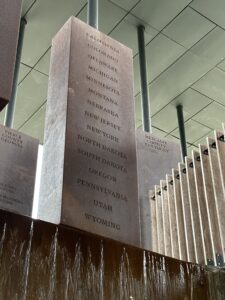 The monument itself was extremely powerful with its dark metal slabs hanging from above and below, creating the semblance of a giant graveyard filled with tombstones, etched with the names of the dead, designated by county and state. The memorial is on a large piece of property, and it takes quite some time to walk through it, giving you lots of opportunity to reflect on all these people who were murdered because of the color of their skin. There was even a documented lynching in New Jersey. I highly recommend visiting The National Memorial for Peace and Justice, and its affiliate The Legacy Museum. You will learn and experience things that will make a profound impression on you and open your eyes to how poorly our country has treated Black people dating back the the 1600’s when millions of them were kidnapped from Africa and brought to the US as slaves.
The monument itself was extremely powerful with its dark metal slabs hanging from above and below, creating the semblance of a giant graveyard filled with tombstones, etched with the names of the dead, designated by county and state. The memorial is on a large piece of property, and it takes quite some time to walk through it, giving you lots of opportunity to reflect on all these people who were murdered because of the color of their skin. There was even a documented lynching in New Jersey. I highly recommend visiting The National Memorial for Peace and Justice, and its affiliate The Legacy Museum. You will learn and experience things that will make a profound impression on you and open your eyes to how poorly our country has treated Black people dating back the the 1600’s when millions of them were kidnapped from Africa and brought to the US as slaves.
Image: “Mug shots” by US Department of State is licensed under CC BY-NC 2.0.
Photos taken by Sarita Eisenberg and Miriam Haimes.
- Parashat Metzora / Shabbat HaGadol – 4/20/24 - Thu, Apr 25, 2024
- Passover Reflections: Seder During Wartime - Thu, Apr 18, 2024
- Parashat Tazria – 4/13/24 - Thu, Apr 18, 2024

